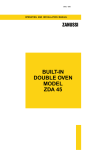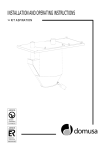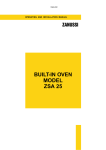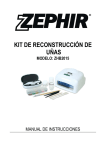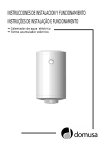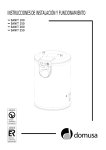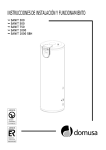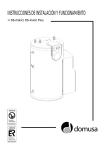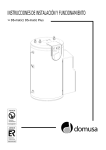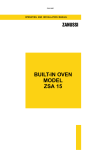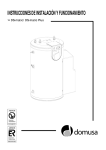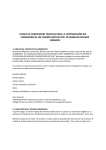Download INSTALLATION AND OPERATING INSTRUCTIONS
Transcript
INSTALLATION AND OPERATING INSTRUCTIONS ¬ SPIDER KIT CGM-04/392 ER-0170/1996 Thank you for choosing a DOMUSA product. From the range of DOMUSA products you have chosen the Spider Kit. With suitable installation and connected to a pellet boiler, this accessory will provide the ideal level of comfort for your home. This manual forms an essential part of the product and it must be supplied to the user. Read the warnings and recommendations in the manual carefully, as they contain important information on the safety, use and maintenance of the installation. This accessory must be installed by qualified personnel only, in accordance with current legislation and following the manufacturer’s instructions. Start-up of these products and any maintenance operations must only be carried out by DOMUSA Official Technical Assistance Services. Incorrect installation of this appliance could result in injury or damage to people, animals or property, and the manufacturer will hold no liability in such cases. CONTENTS Page 1 SAFETY WARNINGS .....................................................................................................................................................2 2 LIST OF COMPONENTS...............................................................................................................................................3 3 INSTALLATION INSTRUCTIONS ...............................................................................................................................4 4 OPERATION ....................................................................................................................................................................8 5 TECHNICAL CHARACTERISTICS............................................................................................................................ 11 6 ELECTRICAL CONNECTION .................................................................................................................................... 12 1.1 1.2 3.1 3.2 3.3 3.4 4.1 4.2 FUEL WARNINGS .......................................................................................................................................................................... 3 ASSEMBLY AND INSTALLATION WARNINGS ............................................................................................................................... 3 ASSEMBLING THE SPIDER KIT ..................................................................................................................................................... 4 DIMENSIONAL CHARACTERISTICS OF THE MAIN SILO ............................................................................................................... 5 FILLING THE SILO ......................................................................................................................................................................... 5 CHARACTERISTICS OF THE SUCTION HOSE................................................................................................................................. 6 OPTIMUM CYCLE TIMES............................................................................................................................................................... 9 PELLET REMOVAL.......................................................................................................................................................................10 1 Spider 1 SAFETY WARNINGS Carefully read this instruction manual and keep it in a safe, easily-accessible place. DOMUSA will not be liable for any damages caused by failure to follow these instructions. To guarantee optimum functioning of this kit and a long lifetime, the installation and maintenance must be carried out by qualified personnel authorised by DOMUSA. The installer is responsible for any devices or controls not supplied with the kit. This appliance must only be used for the purpose for which it has been expressly designed. Any other use is considered unsuitable and therefore hazardous. The manufacturer shall not be considered liable under any circumstances for damage caused by unsuitable, erroneous or irrational use. The Spider Kit is specifically designed for extracting 6 mm diameter pellets from a main silo and, in combination with a pneumatic “Kit Aspiration” system, conveying them to a Bioclass boiler reserve tank. During installation or before any servicing, the following indications must be observed to prevent personal injury or material damage: • Remove all the packaging and check all the contents are included. In the event of any doubt, do not use the kit. Contact your supplier. Keep the packaging elements out of reach of children, as they can be dangerous. • Unplug the Spider Kit from the mains power supply before any servicing and during installation. • For safety reasons, another person should always be present when you access the pellet store. If access to the store is difficult, we recommend a second person waits outside to guarantee the safety of the person entering the store, and who can let them out in case of hazard without endangering their own life. • Before entering the pellet store, ensure it is correctly ventilated (there may be a lack of oxygen or concentration of unknown gases). • Always wear a protective mask (standard mask) inside the pellet store for protection from airborne dust. • Keep children away while you are working in the pellet store. • If the pellet store is flooded there is no risk of contamination of the groundwater, the soil and/or the building, although the tank and pellet removal system could be damaged. • When you no longer wish to use this kit, disable all parts that could be a potential source of hazard. 2 1.1 Fuel warnings The Spider Kit is exclusively designed and intended to be used for pneumatic removal of wood pellets with a diameter of 6 mm and a maximum length of 30 mm. The wood pellets used must comply with the DINplus quality standard. IMPORTANT: The pellets are highly hygroscopic. In case of contact with water or damp walls, they will swell and rot and will be unfit for use. 1.2 Assembly and installation warnings The Spider Kit must only be installed by authorised sufficiently qualified personnel. The following regulations and guidelines must be complied with for assembly and use of heating installations: • Legal regulations on accident prevention. • Legal regulations on environmental protection. • Professional association standards for the sector. As regards assembly and use of this kit, the standards and stipulations applicable in the particular country and/or region in which it is installed must be observed. IMPORTANT: The plastic pellet conveyor hose must be earthed to prevent any danger of the silo catching fire due to sparks generated by accumulation of electrostatic charge during the Spider kit’s functioning causing combustion and/or possible deflagration of the pellets. 2 LIST OF COMPONENTS 3 8 4 2 5 1 6 7 1. 2. 3. 4. Suction hose connection socket. Motor casing. Power cord. Fixed plate. 5. 6. 7. 8. Rotary plate. Springs. Earth connection. Grip ring 3 Spider 3 INSTALLATION INSTRUCTIONS 3.1 Assembling the Spider Kit Fit the hose with an interior diameter of 50 mm to the suction hose connection socket using the hose clamp supplied with the kit. Tighten it firmly to prevent any air leaks. Earth the copper wire on the hose Electrically connect the motor, using the connector shown in the following the instructions given in the diagram diagram in the “Electrical connection” section. NOTE: Both ends of the hose must be earthed. 10 cm L Attach the electrical cable to the suction hose using Adjust the length of the suction hose to ensure the Spider plastic cable ties to prevent it from becoming tangled Kit can reach the areas furthest from the silo. while the kit is functioning. When the required length (L) has been defined, suitably NOTE: We recommend fixing the cable to the hose at fasten the hose to the silo structure. intervals of 10 cm to prevent tangling. Ring Fill the silo with pellets, keeping the Spider Kit outside Place the Spider Kit in the silo, on top of the pellets. It is the silo so that it is not dented or damaged by the flow important to centre it as correctly as possible to guarantee even pellet suction over the whole surface. of pellets. To take out the Kit Spider from the silo, use the grip ring placed in the top of the motor casing. 4 3.2 Dimensional characteristics of the main silo The main pellet silo must be constructed by sufficiently trained personnel and must comply with all the national and regional regulations, standards and laws for this sector applicable at the time of construction, particularly those referring to fire safety, boiler rooms and building safety. For the Kit to function correctly, it must be connected to a pneumatic suction system. The Spider Kit has been specially designed for connection to the Kit Aspiration system supplied by DOMUSA. Construction of the main pellet silo must comply with the following size requirements for the Spider Kit to function in combination with the Kit Aspiration system: • The Spider Kit has been designed to cover a maximum circular area of 2 metres in diameter. • The optimum silo size is a maximum of 2 x 2 metres. Providing it complies with these dimensions, it may be square, rectangular or circular. • The minimum permitted silo dimensions are 0.5 metres x 1 metre. • A minimum height of 0.5 metres is recommended. • There are no requirements with regard to maximum silo height, although it must be low enough to allow for suitable filling. If a silo larger than the above-mentioned sizes is required, we recommend constructing it with tilted sides, as shown in the picture below. 2m 2m 3.3 Filling the silo It is recommendable to remove the Spider Kit before filling and keep it outside the silo during the filling process, to prevent it from being dented or damaged by the flow of pellets. When the silo is full, stand the kit on the pellets again in the centre of the silo if possible, to ensure uniform suction over the entire surface. IMPORTANT: Correct functioning of the Spider Kit is only guaranteed if the wood pellets used as fuel comply with the DINplus quality standard. 5 Spider 3.4 Characteristics of the suction hose The Spider Kit for pellet removal and the pneumatic Kit Aspiration conveyor system, working in combination, are specially designed to function with an installation consisting of a plastic hose with an interior diameter of 50 mm. This hose must also have a static electricity discharge system, preferably a copper wire wound around its entire length. This copper wire must be earthed at all the hose joints and ends. Whatever the type of hose used, it must be made of a suitable material for wood pellet transport and it must always have an interior diameter of 50 mm. The following recommendations must also be complied with for correctly installing the Spider Kit in combination with the Kit Aspiration: • The maximum permitted hose length is 30 metres for flow from the main silo to the suction pot and 30 metres for return. • Bend angles of over 45º must be avoided wherever possible. If these cannot be avoided, any curves with angles of over 45º must have a radius of curvature greater than 125 mm. • If rigid plastic tubing is used, do not use standard 90º elbows. If these are necessary, the curves constructed must have a minimum radius of 125 mm. • The maximum height difference permitted for the installation is 6 metres. • Avoid any splicing or coupling in the hose installation wherever possible, as this may narrow the circuit which can cause clogging of the pellets conveyed and could block the system. Most importantly, avoid any joints in the hose section leading from the main silo to the boiler reserve tank suction pot, as the pellets are conveyed through this section. • If there is no alternative to splicing and extending the installation, straight rigid tubing with an interior diameter of 50 mm must be used. It is preferable for any splicing and joining of the hose to be made in the pneumatic suction system return section, as only air is conveyed in this section. All the hose sections must be earthed at all coupling points and at the ends of the hose. • The most significant factor for ensuring maximum suction power for the system is the airtightness of the installation, and great care must therefore be taken on installing the tubing. All coupling points in the installation must be secured with brackets, taking special care to prevent leakage. • We recommend avoiding hose crossover in the installation wherever possible. The flow and return hoses of the pneumatic installation should be laid parallel to each other. • For correct assembly of the hoses, they should be fixed to the walls and/or floor using suitable hose clamps throughout the entire installation, to ensure stability. The recommended maximum distance between the fixing points is 80 – 110 cm. 6 Some of the above recommendations are shown in the figure below: KIT ASPIRATION KIT SPIDER MAIN SILO RESERVE TANK IMPORTANT: At each end of the pellet suction and air return hose, the copper cables must be connected to the earth connection terminals provided for this purpose. IMPORTANT: DOMUSA will hold no liability for any malfunctioning of the Spider Kit in combination with the Kit Aspiration if the installation does not comply with the above recommendations. 7 Spider 4 OPERATION The Spider Kit removes pellets to a main pellet store or silo and, in combination with the pneumatic suction system (Kit Aspiration), conveys these pellets to a smaller storage unit near the boiler (Reserve Tank). The Spider Kit basically consists of a pneumatic connection, where the pellet suction hose is connected, and a motor that turns a mobile plate on the underside of the kit and removes the pellets from the main silo. The pellets are then sucked up by the pneumatic Kit Aspiration system. The rotary plate moves in circular fashion in symmetrical rotation cycles, alternating between clockwise and counter-clockwise movement to prevent the hose from winding onto the kit. At the same time, the suction system functions in cycles of a fixed duration to fill the suction pot in the Bioclass boiler reserve tank. These suction pot filling cycles and the Spider Kit rotation cycles are governed by the Kit Aspiration electronic control system. The figure below shows a functional diagram of the Spider Kit installed in combination with a Kit Aspiration: General system operation is as follows: when the level sensor detects a low pellet level, the electronic control starts up the suction unit and the Spider Kit motor, which begins to suck up the pellets from the silo or main store and convey them to the suction pot in the upper part of the boiler reserve tank. The suction unit runs for a set duration (a cycle), while it fills the suction pot. When the cycle is complete, the suction unit stops and the hatch on the underside of the suction pot opens, emptying the pellets inside it into the reserve tank. If the level sensor continues to detect no pellets when the suction pot has been emptied, the suction unit starts up again and runs for another full cycle. When the sensor detects pellets, the electronic control disables the functioning of the Kit Aspiration and then remains on standby until it requires activation again. 8 If the level sensor continues to detect no pellets after 8 consecutive cycles, the electronic control blocks the system functioning and the pilot light on the side of the control will come on to indicate a system anomaly. To unblock the system, disconnect the electronic control from the mains supply and then reconnect it. 4.1 Optimum cycle times When the Spider Kit is installed in combination with the Kit Aspiration, the cycle time can be adjusted using the adjustment screw on the side of the electronic control. This screw is used to optimise the filling time for the suction pot in the upper part of the reserve tank, adapting it to the different characteristics of each pneumatic installation. The adjustable time range is from a minimum of 27 seconds per cycle to a maximum of 187. The Kit Aspiration electronic control starts up each cycle by activating the suction unit and the Spider Kit motor at the same time, turning the rotary plate and starting up the pellet suction process from the main silo. When the cycle is complete, in order to prevent excess pellets remaining in the hose installation and causing obstruction at the start of the next cycle, the control stops the Spider Kit functioning 7 seconds before suction unit operation is disabled. This means the suction unit continues taking in only the pellets that remain in the hose installation, emptying the hose and preventing obstruction when the next cycle begins. In general, we recommend adjusting the cycle time to its maximum setting, by turning the adjustment screw clockwise as far as it will go. If the installation settings are causing the Kit Aspiration to fill up some time before the end of each cycle, we recommend reducing the cycle time for closer regulation, so that it coincides with each filling of the suction pot. It should also be observed that the amount of pellets taken in on each cycle may vary considerably depending on vacuum cleaner's filter maintenance, pellet quality and the main silo emptying level at any given time, and it is therefore preferable to set long cycle times. The diagram below shows the functioning cycles governed by the Kit Aspiration electronic control: IMPORTANT: Thorough periodic maintenance of the Kit Aspiration’s filter is vital to ensure sufficient uniform pellet suction flow. NOTE: If you choose to install the Spider Kit with a control and suction system other than the Kit Aspiration supplied by DOMUSA, we recommend adjusting its functioning to the cycle types and times described above. DOMUSA does not guarantee correct functioning of the kit if other cycle types and times are used. 9 Spider 4.2 Pellet removal Pellets are a bulk product and they vary naturally in length, diameter and accumulation of volatile material and dust. The pellet removal process described here may vary depending on the quality of the pellets used and on the particular silo design. To ensure optimum, uniform and durable functioning of the Spider removal system, it is vital to use high quality wood pellets of 6 mm diameter, compliant with the DINplus quality standard. The Spider Kit, used in combination with the Kit Aspiration, can cover a silo surface area of up to 2 x 2 metres and can empty up to 80% of the silo’s total volume capacity, with suitable maintenance of the suction system filter. It is also recommended to periodically inspect the silo emptying level, ensuring the pellet distribution in the silo is as even as possible at all times, as the amount of pellets removed in each cycle may vary greatly as indicated above, meaning more removal cycles are sometimes needed to fill the tank. When the silo is completely full, the Spider Kit begins to form a cavity or a funnel effect, sucking in the pellets from the top of the silo until it reaches the bottom. On reaching the base of the silo, the kit then moves towards the sides, rotating in both directions. The diagram below shows how the Spider Kit removes the pellets: IMPORTANT: Correct functioning of the Spider Kit can only be guaranteed if the wood pellets used comply with the DINplus quality standard. IMPORTANT: It is important to position the Spider Kit in the centre of the silo and ensure there are pellets underneath and around it, to guarantee even coverage of the entire surface. 10 5 TECHNICAL CHARACTERISTICS The technical characteristics listed in the table below refer to installation of the Spider Kit in combination with a pneumatic suction system – the Kit Aspiration – both supplied by DOMUSA. TECHNICAL CHARACTERISTICS Maximum amount of pellets conveyed (*) (**) VALUE Kg/min. 3-6 Maximum suction length (*) m 30 Maximum suction height (*) m 6 mm 50 Connection voltage - 230 V~ 50 Hz Maximum electricity consumption A 0.15 Maximum electric power W 10 Motor capacitor µF 1 Motor class - Class B Motor protection degree - IP 40 Threaded joint protection degree - IP 60 Weight Kg 5 Spider Kit diameter mm 625 Spider Kit height mm 230 ATEX equipment group - II ATEX equipment category - 300D T100 Suction hose diameter (*) This value only refers to installations made in combination with the Kit Aspiration optionally supplied by DOMUSA. (**) This value will vary depending on the amount of dirt on the vacuum clener's filter, the maintenance of the Kit Aspiration pneumatic suction system, the length of the pneumatic installation and the quality of the wood pellets. 11 Spider 6 ELECTRICAL CONNECTION The Spider Kit is designed for a 230 V~, 50 Hz electrical connection. For it to function correctly, the cable supplied with the kit must be connected as shown in the connection diagram below. Remember to earth the appliance. If the Spider Kit is installed in combination with a Kit Aspiration supplied by DOMUSA, the indications given in the diagram below must be followed for correct electrical connection to the terminal strip of the Kit Aspiration’s electronic control: NOTE: The power supply must be connected so that the kit can be totally isolated and disconnected in order to safely carry out any maintenance operations. 12 NOTES: .............................................................................................................................................................................................................. .............................................................................................................................................................................................................. .............................................................................................................................................................................................................. .............................................................................................................................................................................................................. .............................................................................................................................................................................................................. .............................................................................................................................................................................................................. .............................................................................................................................................................................................................. .............................................................................................................................................................................................................. .............................................................................................................................................................................................................. .............................................................................................................................................................................................................. .............................................................................................................................................................................................................. .............................................................................................................................................................................................................. .............................................................................................................................................................................................................. .............................................................................................................................................................................................................. .............................................................................................................................................................................................................. .............................................................................................................................................................................................................. .............................................................................................................................................................................................................. .............................................................................................................................................................................................................. .............................................................................................................................................................................................................. .............................................................................................................................................................................................................. .............................................................................................................................................................................................................. .............................................................................................................................................................................................................. .............................................................................................................................................................................................................. .............................................................................................................................................................................................................. .............................................................................................................................................................................................................. .............................................................................................................................................................................................................. .............................................................................................................................................................................................................. .............................................................................................................................................................................................................. 13 POSTAL ADDRESS FACTORY AND OFFICES Apartado 95 Bº San Esteban s/n 20730 AZPEITIA 20737 ERREZIL (Guipúzcoa) Tel: (+34) 943 813 899 Fax: (+34) 943 815 666 www.domusa.es DOMUSA reserves the right to make modifications of any kind to its product characteristics without prior notice. *CDOC000786* CDOC000786 05/13

















